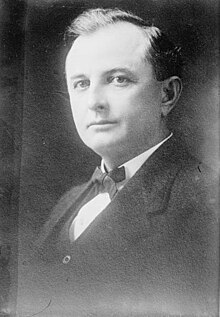James E. Ferguson
James Edward "Pa" Ferguson (born August 31, 1871 in Salado , Texas , † September 21, 1944 in Austin , Texas) was an American politician and from 1915 to 1917 governor of the state of Texas.
Early years
James Ferguson attended Salado College but was expelled from the institution for indiscipline. He then earned his living as a temporary worker in various positions in the western United States. He worked in the vineyards of California , the logging industry in Washington state, and the quartz mines of Colorado and Nevada . He then returned to Texas, where he worked as a bridge foreman. Then he also studied law in Texas. In 1897 he was admitted to the bar. He then worked as a lawyer in Belton . At that time, he also got into other businesses such as insurance, real estate, and banking. In 1907 he moved to Temple , where he founded the Temple State Bank with some partners .
Texas Governor
James Ferguson was a member of the Democratic Party . Until his election as governor, he was politically more in the second tier. He led the election campaigns of some governors and senators and was known to oppose prohibition . After some internal party discussions between supporters and opponents of Prohibition, Ferguson was nominated as his party's candidate for the 1914 gubernatorial election. After winning the election, he was able to take up his new office on January 19, 1915. In his first term of office, which ran until January 1917, he campaigned for school reform. At that time, among other things, compulsory schooling was officially introduced and three new institutions for teacher training were created.
In the gubernatorial elections of 1916, Ferguson was expected to be re-elected. But rumors of irregularities arose during the election campaign. Among other things, he was accused of embezzling state funds. There was also a dispute with the University of Texas . The administration of this university had refused to dismiss some of the faculty members at Ferguson's request. This then blocked all funds intended for the university. In the meantime, the allegations of fraud and embezzlement had been substantiated and a procedure to impeach Governor Ferguson was initiated. When it became evident that he was about to be removed from office, he resigned from his post on August 25, 1917, the day before the expected verdict. His lieutenant governor William P. Hobby succeeded him.
Separately, the state of Texas had to make its contribution to the war effort of the federal government under President Woodrow Wilson for the First World War . That meant: rationing food and fuel, recruiting new soldiers for the armed forces and converting production to armaments.
Another résumé
James Ferguson did not come to terms with his failed governorship. In the following years he applied unsuccessfully for a return to his former office, for a seat in the US Senate (1922) and in 1920 even as a candidate for the short-lived American Party for the American presidency. He and his running mate William Jervis Hough did not get more than 47,968 votes, which corresponded to a share of 0.2 percent. Then he supported the successful election campaigns of his wife Miriam , who was elected governor of Texas in 1924 and 1932, respectively. James Ferguson died in 1944. He and Miriam Ferguson had two children together.
literature
- Bruce A. Glasrud (Ed.): Impeached: The Removal of Texas Governor James E. Ferguson. Texas A&M University Press, College Station 2017, ISBN 978-1-62349-527-5 .
- Robert Sobel and John Raimo (Eds.): Biographical Directory of the Governors of the United States, 1789–1978. Volume 4, Meckler Books, Westport, 1978. 4 volumes.
Web links
- James E. Ferguson at the National Governors Association (English)
- James E. Ferguson in the Handbook of Texas (English)
- James E. Ferguson in The Political Graveyard
- James E. Ferguson in the database of Find a Grave (English)
| personal data | |
|---|---|
| SURNAME | Ferguson, James E. |
| ALTERNATIVE NAMES | Pa Ferguson |
| BRIEF DESCRIPTION | American politician |
| DATE OF BIRTH | August 31, 1871 |
| PLACE OF BIRTH | Salado , Texas |
| DATE OF DEATH | September 21, 1944 |
| Place of death | Austin , Texas |

